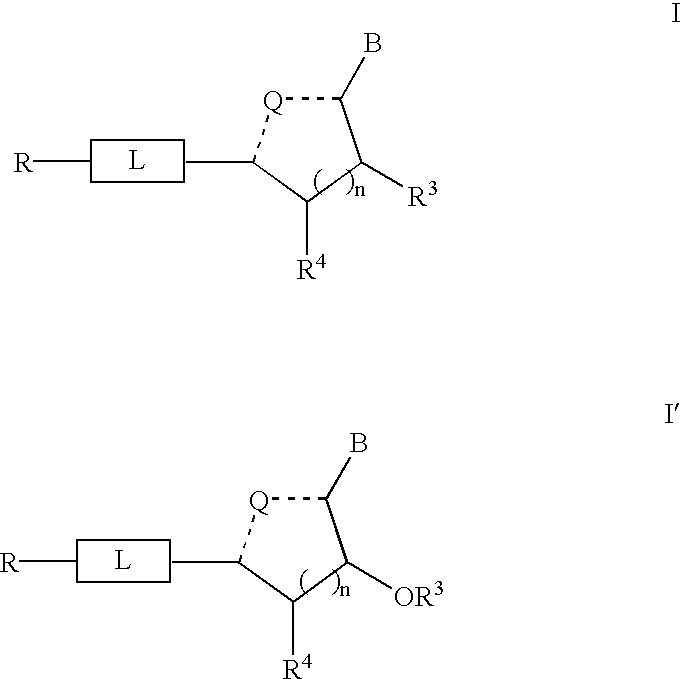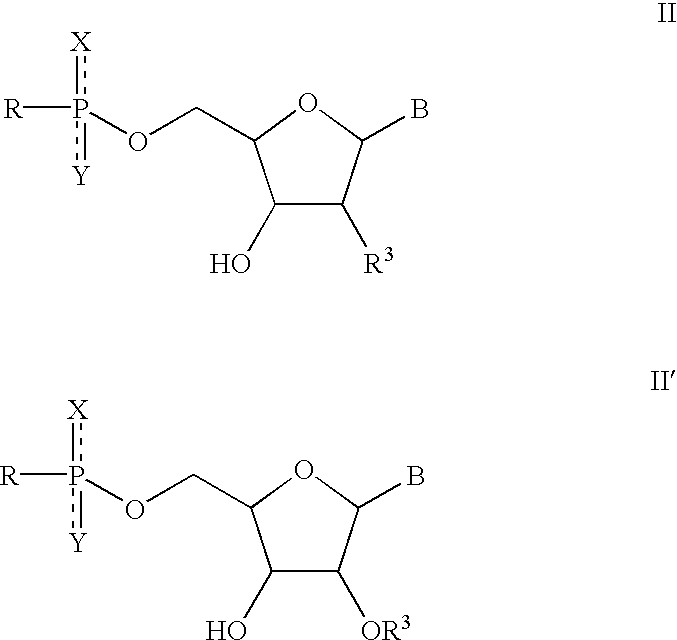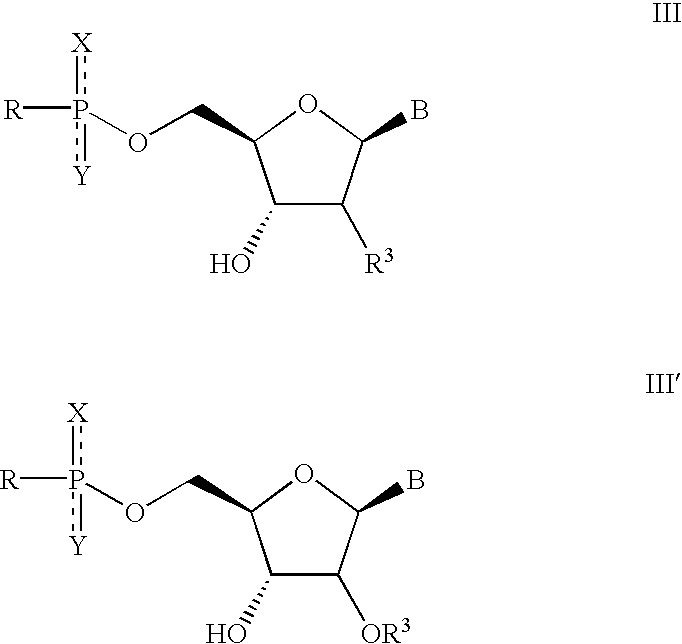Solution-phase combinatorial library synthesis and pharmaceutically active compounds produced thereby
a technology of combinatorial library and library, which is applied in the direction of instruments, organic chemistry, sugar derivatives, etc., can solve the problems of inability to synthesise solid phase, limited yield of compounds produced by such a method, and multiple ways of limited solid phase synthesis procedures
- Summary
- Abstract
- Description
- Claims
- Application Information
AI Technical Summary
Benefits of technology
Problems solved by technology
Method used
Image
Examples
example 1
Synthesis of Nucleoside Building Blocks (Schemes 1 and 3).
[0081] The nucleoside building blocks 5a-f were synthesized from commercially available nucleosides 2a-f via 3,4a-f as shown in scheme 1 and 3.
[0082] Step 1. Conversion of 2a-f to 3a-f.
[0083] Each of nucleosides 2a-f (4 millimol) was co-evaporated twice with anhydrous pyridine (50 mL). The reaction was placed in an ice bath, and benzoyl chloride (5 millimol) was added dropwise to the solution with stirring. The ice-bath was removed, and stirring continued for about 3 hours. The reaction mixture was then poured slowly into a flask containing ice-cold saturated aqueous sodium carbonate (500 mL) with vigorous stirring. The resulting white precipitate was collected and washed exhaustively with water to remove all pyridine. The products, 3a-f, were dried overnight in vacuo.
[0084] Step 2. Conversion of 3a-f to 4a-f.
[0085] Each of the nucleosides 3a-f obtained as above was dissolved in chloroform (200 mL) and treated with trifluoroa...
example 2
Synthesis of a 150 Member (Products 1a-i to 1a-xxv) (See Schemes 2, 4 and 5, Table 1).
[0095] Each alcohol shown in Table 2 (i-xxv) (30 micromol) and each of the nucleoside amidites 5a-f (20 micromol) were added sequentially to a series of conical microtubes (2 mL, Ultident Scientific) containing lH-tetrazole solution in acetonitrile (1 mL, 100 micromol). The mixture was shaken in a platform shaker at room temperature for five minutes. Then 3H-BD (40 micromol) was added as a solid and the contents shaken for another 5 minutes. The acetonitrile was evaporated in a Speed Vac. Ethyl acetate (0.8 mL) was then added, followed by aqueous sodium bicarbonate (0.4 mL). Following thorough mixing of the phases, the organic layer containing the intermediate thiophosphate triester 8 was separated and evaporated to dryness. Aqueous ammonium hydroxide (28%, 1 mL) was added to the residue in each microtube. The tightly capped tubes were heated at 55.degree. C for 3 hours. The aqueous ammoniacal solu...
example 3
HPLC Analysis of Library Members 1 (Table 2).
[0096] Reversed-phase analytical HPLC was performed on a Waters 600 system equipped with a photodiode-array UV detector 996, autosampler 717, and Millenium 2000 software, using a Radial-Pak liquid chromatography cartridge [8 mm I.D., 8NVC 18]. Mobile phase: Buffer A: 0.1 M NH.sub.4OAc; Buffer B: 20% A / 80% CH.sub.3CN v / v. Gradient: 100% A, 0-3 minutes; 40% A, 40 minutes; 100% B, 49 minutes).
7TABLE 2 HPLC and .sup.31P NMR data of representative library members. Nucleosides 5a-f were combined with alcohols i-xxv to form a 150 member compound library. The compounds analyzed are represented by the nucleoside (number and letter) followed by the Roman number of the alcohol which corresponds to the numbers in Table 1. Library HPLC Members R.sub.1 (Min) .sup.31P (ppm) 1a-i 30.5 58.97, 58.64 1b-i 28.6 58.96 1c-i 28.1 58.91, 58.61 1d-i 29.7 58.32, 58.24 1a-xix 36.0 59.39, 59.33 1b-xix 35.1 59.75, 59.24 1c-xix 33.6 59.36, 59.21 1d-xix 38.2 59.72, 59....
PUM
| Property | Measurement | Unit |
|---|---|---|
| Force | aaaaa | aaaaa |
| Molar density | aaaaa | aaaaa |
| Fraction | aaaaa | aaaaa |
Abstract
Description
Claims
Application Information
 Login to View More
Login to View More - R&D
- Intellectual Property
- Life Sciences
- Materials
- Tech Scout
- Unparalleled Data Quality
- Higher Quality Content
- 60% Fewer Hallucinations
Browse by: Latest US Patents, China's latest patents, Technical Efficacy Thesaurus, Application Domain, Technology Topic, Popular Technical Reports.
© 2025 PatSnap. All rights reserved.Legal|Privacy policy|Modern Slavery Act Transparency Statement|Sitemap|About US| Contact US: help@patsnap.com



